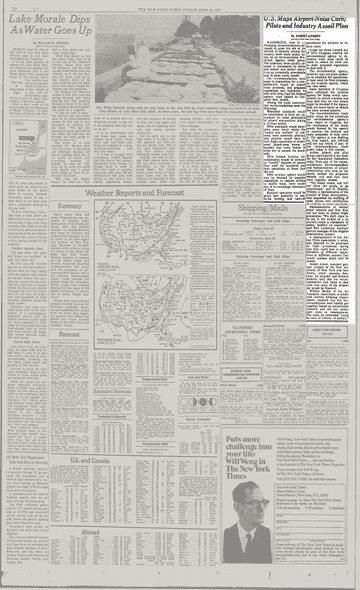Article Summary:

WASHINGTON, June 21 —Sweeping recommendations designed to quiet the din of jet aircraft at airports around the country were made public to day by an Environmental Protection Agency study group. The proposals were quickly as sailed in statements by pilots and airport and airline executives as potentially unworkable and, in some cases, unsafe.
The recommendations were made in preparation for a comprehensive report on airport noise problems, and proposed regulations and legislation to deal with them, that the Federal agency, must submit to Congress next month.
Among the most controversial recommendations were the following:
National standards would be established to limit the cumulative jet noise permissible in airport communities during a 24‐hour period.
The standards would deter mine noise limits where the “health and welfare” of residents were adversely affected, and airports would have to limit flight operations or sound proof airport‐area homes or possibly buy some homes in order not to exceed the standards.
The Federal Aviation Ad ministration would be directed to “certify” airports to assure they meet the standards and limit operations at those that did not.
The aviation agency would also be directed to expedite regulations to require airlines to muffle noisy, early model jets Or to encourage retirement of them.
Airport operators would be given new authority to prescribe landing and take‐off procedures for airliners to reduce noise.
Under the Noise Control Act of 1972, Congress ordered the environmental agency to determine what steps could be taken to reduce jet noise and to draft proposed regulations to deal with it.
The environmental agency, however, was not given author ity to establish the regulations. It must send its final proposals to the aviation agency, which can veto them.
Some members of Congress have criticized the aviation agency for being overly sympathetic to airline interests and have said that its veto power might be revoked if the agency does not move faster to reduce the noise around airports.
The recommendations made public today do not constitute the environmental agency’s final report to Congress, but the conclusions of six study panels formed by the agency to examine the problem and make proposals to help solve it. The agency is now drafting its final report, and officials will not say which, if any, of the recommendations made public today it will contain.
Airline, airport and pilot groups participated in the stud ies but dissociated themselves today from any of the recommendations. Environmentalists and representatives of airport communities who were on the panels backed the proposals warmly and said that they were urgently needed.
“The states cannot and will not allow the people to go unprotected,” said R. Timothy Weston, a representative of the Council of State Governments, who supported the muffling of of airports on noise standards.
Representatives of several major airports said that they did not want to dictate flight procedures. “We don’t want to be put in the cockpit of a jet aircraft—from a standpoint of safety, liability or expertise,” said Bert Lockwood, assistant general manager of Los Angeles International Airport.
A representative of the Airline Pilots Association, a union, also objected to the proposals on flight procedures, saying that they could lead to a proliferation of different regulations at different airports that would confuse pilots and be unsafe.
Joseph Lesser, assistant general counsel of the Port Authority of New York and New Jersey, which operates Kennedy, La Guardia and Newark airports said that the recommendations had failed to deal with how some of the proposals would be financed.
William Becker of the Air Transport Association, a scheduled airlines lobbying organization, asserted that the recommendations were hastily put together, based on questionable research and did not anticipate costs or consequences. The costs, he contended, “could be tens of billions of dollars.”